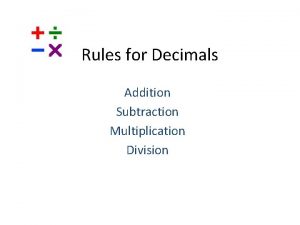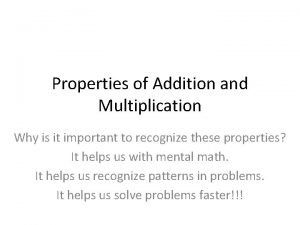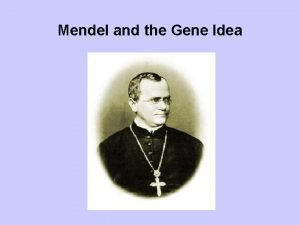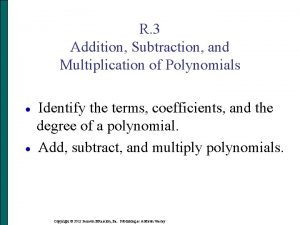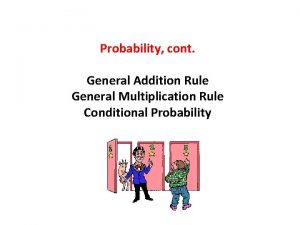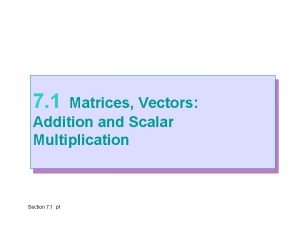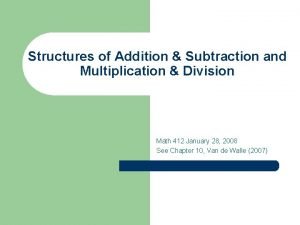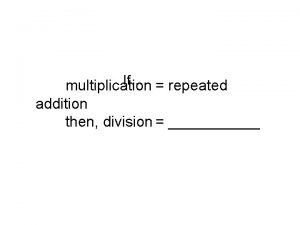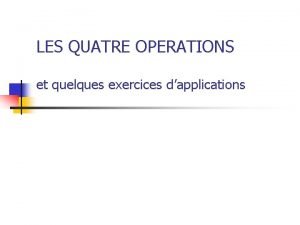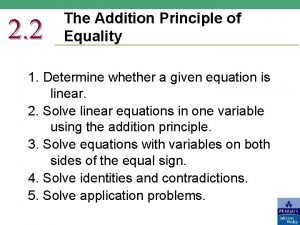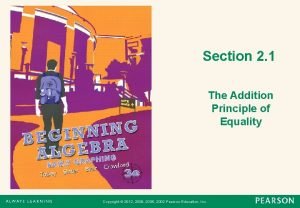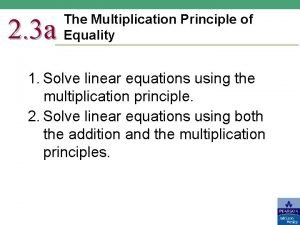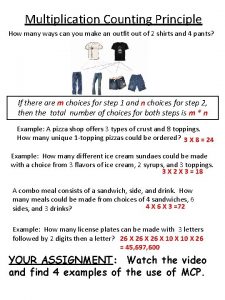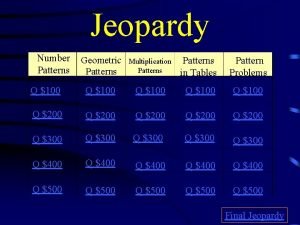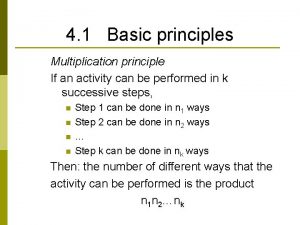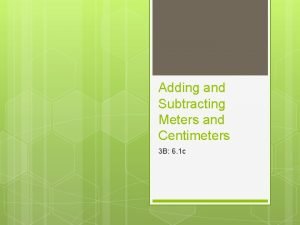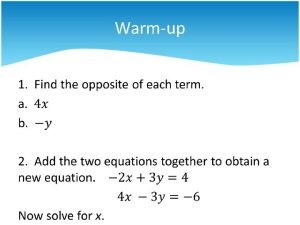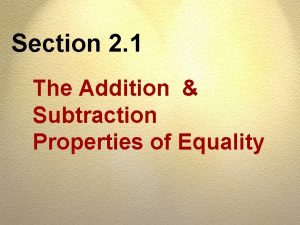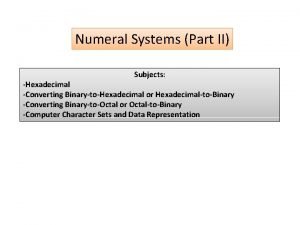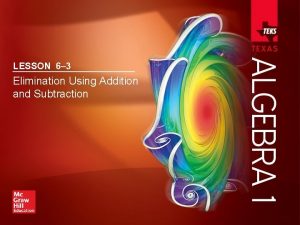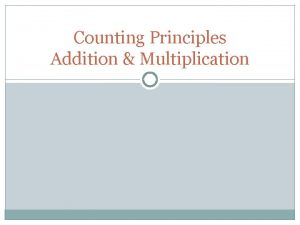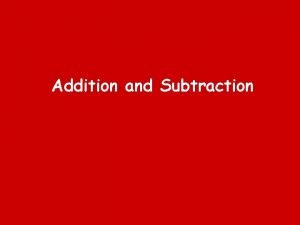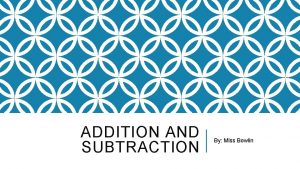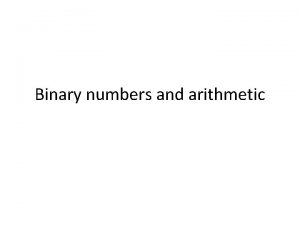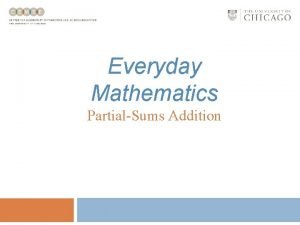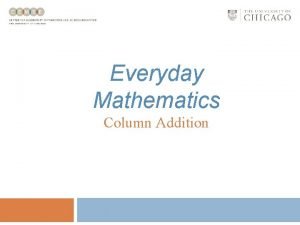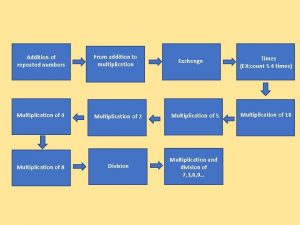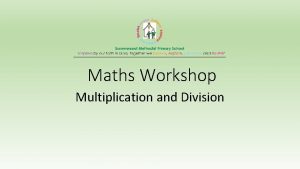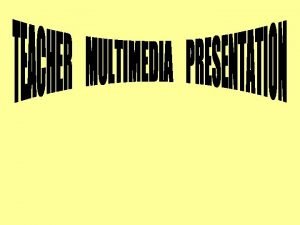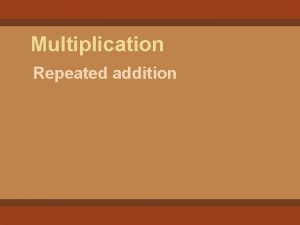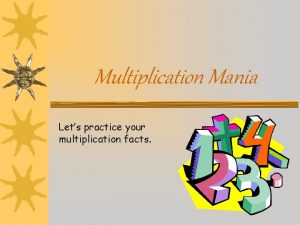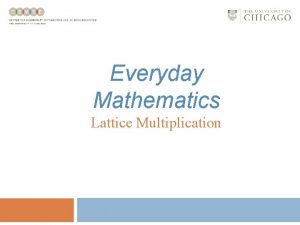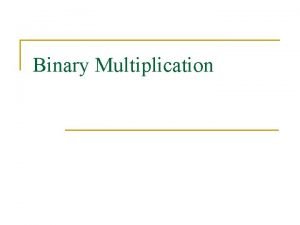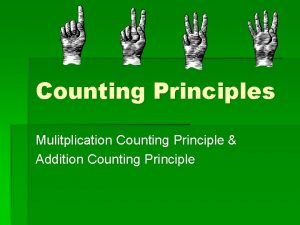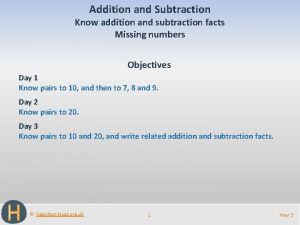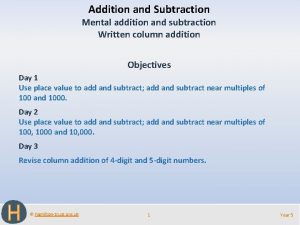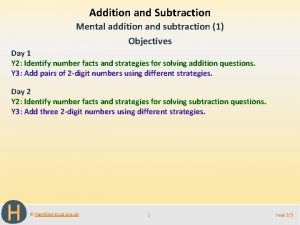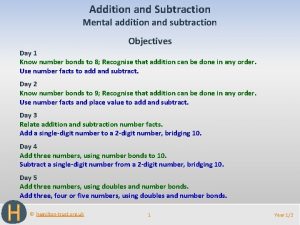Multiplication Principle and Addition Principle 1 Multiplication Principle






















- Slides: 22

Multiplication Principle and Addition Principle 1. Multiplication Principle: Suppose a task is accomplished by n steps and each step requires a choice from a number of available choices. Let these numbers be A 1, A 2, . . . An 2. Then, the total number of ways to accomplish this task is 3. A 1 x A 2 x A 3 x. . An. 2. Addition Principle: Suppose a task is accomplished by choosing an object from the union of disjoint sets with cardinalities B 1, B 2, B 3, . . . Bn. Then, the total number of ways to accomplish this task is B 1+ B 2+ B 3 +. . . Bn.



Set Theoretic Descriptions of the two principles • The cardinality of the Cartesian product of n sets A 1, A 2, . . An is given by n (A 1 x A 2 x. . . An) = n(A 1). n(A 2). . . n(An). • The cardinality of the disjoint union of n sets B 1, B 2, . . Bn is given by n (B 1 U B 2 U. . . Bn)= n(B 1) + n(B 2)+. . . + n(Bn)

Examples • On a table, there is a pile of 10 apples and another pile of 15 pears. 1. How many choices do you have if you are instructed to pick an apple and a pear? 2. How many choices do you have if you are instructed to pick an apple or a pear?

Mistakes you must avoid • Suppose there are 4 doctors and 5 chess players in a room with 7 people. If you are instructed to pick a doctor or a chess player in this room (and slap the face) how many choices do you have? Is your answer 4+5 = 9 ? Then, review your knowledge of addition principle.

Read the problems carefully. In a room, there are 7 people. Everyone in that room is either a chess player or a doctor. 4 of them are doctors and 5 of them are chess players. In how many ways can one accomplish each of the following tasks? 1. Task is to get into the room, pick a chess player and play a chess with. Then, pick a doctor and ask for an opinion about your asthma symptom. 2. Task is to pick a team of two people, consisting of one chess player and one doctor.

• Addition Principle is frequently applied in a form of `subtraction’ principle. n(A B) = n(A) – n(B) Example: In a basket of 30 Easter eggs, there are 7 green eggs. Your task is to pick an egg that is not green. How many choices do you have? The answer: 30 -7= 23. 23 choices. Another Example: (See the Venn diagram of chess players and doctors. ) We will approach the second question in the previous slide in the following way. Initially, we write a name of a chess player and (next to it) write a name of a doctor. Consider this writing as a tentative list of 2 -team members. There are 5 x 4=20 possible ways of writing a pair of names in this way. But, exactly 2 of them are a pair of names of a same person (which is not permitted). So, the answer to the second question ( of forming a team of chess_player-doctor pair) is 20 -2=18.

Multiplication Principle is frequently applied in the form of Division Principle. • Division Principle: If A=B x C (cartesion product of B and C), then n(B) = n(A) / n(C). EXAMPLE 1: Gregor Samsa goes to walk every morning wearing a hat and carrying a cane. He has 2 hats, which are identical except that one is grey and the other is brown. He has 3 canes. He is color blind. In how many ways, can he choose a hat and a cane to go out for a walk based on his discerning ability? Answer: If he were able to tell brown from grey, there would be 2 x 3= 6 ways. But, now that all the hats are identical to him from his view, there are 6 / 2 = 3 ways.

Division Principle re-stated: Suppose a task A consists of accomplishing a task B followed by a task C. Then, the number of ways to accomplish task B is given by the number of ways to accomplish the task A divided by the number of ways to accomplish task C. EXAMPLE 2. How many different words can be formed by rearranging the letters in the word “ELEMENT”? Answer: 7! / 3! ( Explain. . . )

Permutation • Informally, a permutation on a set of n elements is an ordering of these elements. • Formally, a permutation on a set of n elements is a one-to-one correspondence between the set and itself. • Number of permutations on a set of n elements • Generalized Permutation: Let A be a set of n elements and r< n. Any one-to-one function from the set {1, 2, 3, . . r} into the set A is called a generalized permutation of the k elements on the set A. • Number of generalized permutation of r elements on the set of n elements is denoted by n. Pr. • n. P r x (n-r)! = n! by multiplication principle.

Combination • Let r<n. An r-combination on the set of n elements is a subset with cardinality r. • n. Cr denotes the number of all the rcombinations on the set of n elements. • n. Pr and n. Cr are related by the following equation n. Pr = n. Cr x r! (illustrated below)



• Picking a generalized permutation, a one-to-one function from {1, 2, . . r} into The set A of n elements is equivalent to STEP 1: Picking a subset of A that has r elements. STEP 2: Picking a permutation on these r elements. Therefore, n. Pr= n. Cr x r!

Summary • n! = number of permutations on n objects. • n. Pr = number of r-permutations on n objects = • n. Cr = number of r-sets that can be formed from n objects =n Pr / r! =

Partition • Let A be a set of n elements. If, for some subsets A 1, A 2, . . . , Ak that are pairwise disjoint, A= A 1 U A 2 U. . . U Ak then we say {A 1, A 2, . . . Ak} is a partition of A.

Ordered Partition • Let a 1+a 2+. . . ak= n and a 1< a 2<. . ak ( < here means less than or equal to) The sequence of subsets A 1, A 2, . . Ak with cardinalities a 1, a 2, . . . ak is called an ordered partition if these sets are mutually disjoint and their union is the set A.

Number of ordered partitions • • How many ordered partitions of a given type does a set of n element have? Experiment: Consider a set of 7 elements. How many ordered partitions of type (2, 2, 3) are there? The construction of a partition of a given type can be considered as a multi-step task. The number of these steps is 1 less than the number of subsets that form the partition. In this particular experiment, 2 steps. STEP 1: Pick a subset of 2 elements (from 7 elements) STEP 2: Pick a subset of 2 elements (from the remaining 5 elements) Now, we employ the multiplication principle: 7 C 2 x 5 C 2 =

Counting Ordered Partitions of a Given Type Let a 1+a 2+. . . ak = n. The number of type (a 1, a 2, . . ak) partitions of a set of n elements is given by

Application (of partition counting) • How many different words can be formed by rearranging the letters in the word “ MISSISSIPI” ? Discussion: Compare this problem with the following problem: `` How many ordered partitions of the type (1, 1, 4, 4) are there for a set of 10 elements? ”. How are these two problems related?

• Given a 10 element set, imagine these elements are doors along a hall way of a hotel. Imagine your duty is to write letter M on 1 door letter P on 1 door letter S on 4 doors letter I on 4 doors This job is equivalent to forming a word by an arrangement of letters in “MISSISSIPI”. This job is also equivalent to forming a type (1, 1, 4, 4) ordered partition of the 10 element set.
 Multiplication addition principle
Multiplication addition principle Adding decimal rules
Adding decimal rules Inverse property of addition and multiplication
Inverse property of addition and multiplication Multiplication and addition rule genetics
Multiplication and addition rule genetics Addition subtraction and multiplication of polynomials
Addition subtraction and multiplication of polynomials Addition multiplication rule
Addition multiplication rule Condition for matrix multiplication
Condition for matrix multiplication Maths addition subtraction multiplication division
Maths addition subtraction multiplication division If multiplication is repeated addition what is division
If multiplication is repeated addition what is division Arithmetic addition subtraction multiplication division
Arithmetic addition subtraction multiplication division Systeme sexagesimal
Systeme sexagesimal What is addition principle
What is addition principle Addition principle example
Addition principle example Multiplication principle of equality
Multiplication principle of equality Multiplication counting principle
Multiplication counting principle Principle of pattern multiplication
Principle of pattern multiplication Principle of multiplication
Principle of multiplication Adding meters
Adding meters 6-3 elimination using addition and subtraction
6-3 elimination using addition and subtraction Solving equations using addition and subtraction
Solving equations using addition and subtraction Rstuv method
Rstuv method Addition and subtraction of hexadecimal numbers
Addition and subtraction of hexadecimal numbers Elimination using addition and subtraction 6-3
Elimination using addition and subtraction 6-3

